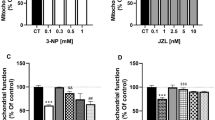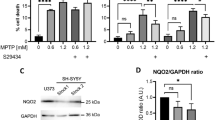Abstract
Growing evidence suggests that the endocannabinoid system plays a role in neuroprotection in Parkinson’s disease. Recently, we have shown the neuroprotective effect of monoacylglycerol lipase (MAGL) inhibition with JZL184 in the chronic 1-methyl-4-phenyl-1,2,3,6-tetrahydropyridine (MPTP) mouse model. However, further investigation is needed to determine the neuroprotective mechanisms of the endocannabinoid system on the nigrostriatal pathway. The aim of this work was to investigate whether the neuroprotective effect of JZL184 in mice could be extended to an in vitro cellular model to further understand the mechanism of action of the drug. The SH-SY5Y cell line was selected based on its dopaminergic-like phenotype and its susceptibility to 1-methyl-4-phenylpyridinium iodide (MPP+) toxicity. Furthermore, SH-SY5Y cells express both cannabinoid receptors, CB1 and CB2. The present study describes the neuroprotective effect of MAGL inhibition with JZL184 in SH-SY5Y cells treated with MPP+. The effect of JZL184 in cell survival was blocked by AM630, a CB2 receptor antagonist, and it was mimicked with JWH133, a CB2 receptor agonist. Rimonabant, a CB1 receptor antagonist, did not affect JZL184-induced cell survival. These results demonstrate that the neuroprotective effect of MAGL inhibition with JZL184 described in animal models of Parkinson’s disease could be extended to in vitro models such as SH-SY5Y cells treated with MPP+. This represents a useful tool to study mechanisms of neuroprotection mediated by MAGL inhibition, and we provide evidence for the possible involvement of CB2 receptors in the improvement of cell survival.





Similar content being viewed by others
Abbreviations
- 2-AG:
-
2-Arachidonoyl glycerol
- AEA:
-
Anandamide
- CB1 :
-
Cannabinoid type 1
- CB2 :
-
Cannabinoid type 2
- ECS:
-
Endocannabinoid system
- FAAH:
-
Fatty acid amide hydrolase
- MAGL:
-
Monoacylglycerol lipase
- MPP+ :
-
1-Methyl-4-phenylpyridinium iodide
- MPTP:
-
1-Methyl-4-phenyl-1,2,3,6-tetrahydropyridine
References
Mechoulam R, Parker LA (2013) The endocannabinoid system and the brain. Annu Rev Psychol 64:21–47. doi:10.1146/annurev-psych-113011-143739
Mechoulam R, Ben-Shabat S, Hanus L, Ligumsky M, Kaminski NE, Schatz AR, Gopher A, Almog S et al (1995) Identification of an endogenous 2-monoglyceride, present in canine gut, that binds to cannabinoid receptors. Biochem Pharmacol 50(1):83–90
Devane WA, Hanus L, Breuer A, Pertwee RG, Stevenson LA, Griffin G, Gibson D, Mandelbaum A et al (1992) Isolation and structure of a brain constituent that binds to the cannabinoid receptor. Science 258(5090):1946–1949
Matsuda LA, Lolait SJ, Brownstein MJ, Young AC, Bonner TI (1990) Structure of a cannabinoid receptor and functional expression of the cloned cDNA. Nature 346(6284):561–564. doi:10.1038/346561a0
Munro S, Thomas KL, Abu-Shaar M (1993) Molecular characterization of a peripheral receptor for cannabinoids. Nature 365(6441):61–65. doi:10.1038/365061a0
Dinh TP, Carpenter D, Leslie FM, Freund TF, Katona I, Sensi SL, Kathuria S, Piomelli D (2002) Brain monoglyceride lipase participating in endocannabinoid inactivation. Proc Natl Acad Sci U S A 99(16):10819–10824. doi:10.1073/pnas.152334899
Cravatt BF, Giang DK, Mayfield SP, Boger DL, Lerner RA, Gilula NB (1996) Molecular characterization of an enzyme that degrades neuromodulatory fatty-acid amides. Nature 384(6604):83–87. doi:10.1038/384083a0
Herkenham M, Lynn AB, Little MD, Johnson MR, Melvin LS, de Costa BR, Rice KC (1990) Cannabinoid receptor localization in brain. Proc Natl Acad Sci U S A 87(5):1932–1936
Ahn K, Johnson DS, Mileni M, Beidler D, Long JZ, McKinney MK, Weerapana E, Sadagopan N et al (2009) Discovery and characterization of a highly selective FAAH inhibitor that reduces inflammatory pain. Chem Biol 16(4):411–420. doi:10.1016/j.chembiol.2009.02.013
Petrosino S, Di Marzo V (2010) FAAH and MAGL inhibitors: therapeutic opportunities from regulating endocannabinoid levels. Curr Opin Investig Drugs 11(1):51–62
Fernandez-Suarez D, Celorrio M, Riezu-Boj JI, Ugarte A, Pacheco R, Gonzalez H, Oyarzabal J, Hillard CJ et al (2014) The monoacylglycerol lipase inhibitor JZL184 is neuroprotective and alters glial cell phenotype in the chronic MPTP mouse model. Neurobiol Aging. doi:10.1016/j.neurobiolaging.2014.05.021
Cabral GA, Raborn ES, Griffin L, Dennis J, Marciano-Cabral F (2008) CB2 receptors in the brain: role in central immune function. Br J Pharmacol 153(2):240–251. doi:10.1038/sj.bjp.0707584
Onaivi ES (2006) Neuropsychobiological evidence for the functional presence and expression of cannabinoid CB2 receptors in the brain. Neuropsychobiology 54(4):231–246. doi:10.1159/000100778
Garcia MC, Cinquina V, Palomo-Garo C, Rabano A, Fernandez-Ruiz J (2015) Identification of CB(2) receptors in human nigral neurons that degenerate in Parkinson’s disease. Neurosci Lett 587:1–4. doi:10.1016/j.neulet.2014.12.003
Lastres-Becker I, Molina-Holgado F, Ramos JA, Mechoulam R, Fernandez-Ruiz J (2005) Cannabinoids provide neuroprotection against 6-hydroxydopamine toxicity in vivo and in vitro: relevance to Parkinson’s disease. Neurobiol Dis 19(1–2):96–107. doi:10.1016/j.nbd.2004.11.009
Price DA, Martinez AA, Seillier A, Koek W, Acosta Y, Fernandez E, Strong R, Lutz B et al (2009) WIN55,212-2, a cannabinoid receptor agonist, protects against nigrostriatal cell loss in the 1-methyl-4-phenyl-1,2,3,6-tetrahydropyridine mouse model of Parkinson’s disease. Eur J Neurosci 29(11):2177–2186. doi:10.1111/j.1460-9568.2009.06764.x
Fall CP, Bennett JP Jr (1999) Characterization and time course of MPP+-induced apoptosis in human SH-SY5Y neuroblastoma cells. J Neurosci Res 55(5):620–628. doi:10.1002/(SICI)1097-4547(19990301)55:5<620::AID-JNR9>3.0.CO;2-S
Pasquariello N, Catanzaro G, Marzano V, Amadio D, Barcaroli D, Oddi S, Federici G, Urbani A et al (2009) Characterization of the endocannabinoid system in human neuronal cells and proteomic analysis of anandamide-induced apoptosis. J Biol Chem 284(43):29413–29426. doi:10.1074/jbc.M109.044412
Hynes J, Floyd S, Soini AE, O’Connor R, Papkovsky DB (2003) Fluorescence-based cell viability screening assays using water-soluble oxygen probes. J Biomol Screen 8(3):264–272. doi:10.1177/1087057103008003004
Yang MC, Chen KP, Lung FW (2014) Generalized estimating equation model and long-term exposure effect of antipsychotics on SH-SY5Y cells against oxidative stressors. Eur J Pharmacol. doi:10.1016/j.ejphar.2014.06.007
De Simoni S, Linard D, Hermans E, Knoops B, Goemaere J (2013) Mitochondrial peroxiredoxin-5 as potential modulator of mitochondria-ER crosstalk in MPP+-induced cell death. J Neurochem 125(3):473–485. doi:10.1111/jnc.12117
Long JZ, Li W, Booker L, Burston JJ, Kinsey SG, Schlosburg JE, Pavon FJ, Serrano AM et al (2009) Selective blockade of 2-arachidonoylglycerol hydrolysis produces cannabinoid behavioral effects. Nat Chem Biol 5(1):37–44. doi:10.1038/nchembio.129
Mor M, Rivara S, Lodola A, Plazzi PV, Tarzia G, Duranti A, Tontini A, Piersanti G et al (2004) Cyclohexylcarbamic acid 3′- or 4′-substituted biphenyl-3-yl esters as fatty acid amide hydrolase inhibitors: synthesis, quantitative structure-activity relationships, and molecular modeling studies. J Med Chem 47(21):4998–5008. doi:10.1021/jm031140x
Biedler JL, Roffler-Tarlov S, Schachner M, Freedman LS (1978) Multiple neurotransmitter synthesis by human neuroblastoma cell lines and clones. Cancer Res 38(11 Pt 1):3751–3757
Farooqui SM (1994) Induction of adenylate cyclase sensitive dopamine D2-receptors in retinoic acid induced differentiated human neuroblastoma SHSY-5Y cells. Life Sci 55(24):1887–1893
Buck KJ, Amara SG (1994) Chimeric dopamine-norepinephrine transporters delineate structural domains influencing selectivity for catecholamines and 1-methyl-4-phenylpyridinium. Proc Natl Acad Sci U S A 91(26):12584–12588
Kallendrusch S, Hobusch C, Ehrlich A, Nowicki M, Ziebell S, Bechmann I, Geisslinger G, Koch M et al (2012) Intrinsic up-regulation of 2-AG favors an area specific neuronal survival in different in vitro models of neuronal damage. PLoS ONE 7(12):e51208. doi:10.1371/journal.pone.0051208
Nomura DK, Morrison BE, Blankman JL, Long JZ, Kinsey SG, Marcondes MC, Ward AM, Hahn YK et al (2011) Endocannabinoid hydrolysis generates brain prostaglandins that promote neuroinflammation. Science 334(6057):809–813. doi:10.1126/science.1209200
Nader J, Rapino C, Gennequin B, Chavant F, Francheteau M, Makriyannis A, Duranti A, Maccarrone M et al (2014) Prior stimulation of the endocannabinoid system prevents methamphetamine-induced dopaminergic neurotoxicity in the striatum through activation of CB receptors. Neuropharmacology. doi:10.1016/j.neuropharm.2014.03.014
Giordano M, Takashima H, Herranz A, Poltorak M, Geller HM, Marone M, Freed WJ (1993) Immortalized GABAergic cell lines derived from rat striatum using a temperature-sensitive allele of the SV40 large T antigen. Exp Neurol 124(2):395–400
Valdeolivas S, Pazos MR, Bisogno T, Piscitelli F, Iannotti FA, Allara M, Sagredo O, Di Marzo V et al (2013) The inhibition of 2-arachidonoyl-glycerol (2-AG) biosynthesis, rather than enhancing striatal damage, protects striatal neurons from malonate-induced death: a potential role of cyclooxygenase-2-dependent metabolism of 2-AG. Cell Death Dis 4:e862. doi:10.1038/cddis.2013.387
Klegeris A, Bissonnette CJ, McGeer PL (2003) Reduction of human monocytic cell neurotoxicity and cytokine secretion by ligands of the cannabinoid-type CB2 receptor. Br J Pharmacol 139(4):775–786. doi:10.1038/sj.bjp.0705304
Garcia C, Palomo-Garo C, Garcia-Arencibia M, Ramos J, Pertwee R, Fernandez-Ruiz J (2011) Symptom-relieving and neuroprotective effects of the phytocannabinoid Delta(9)-THCV in animal models of Parkinson’s disease. Br J Pharmacol 163(7):1495–1506. doi:10.1111/j.1476-5381.2011.01278.x
Gomez-Galvez Y, Palomo-Garo C, Fernandez-Ruiz J, Garcia C (2015) Potential of the cannabinoid CB receptor as a pharmacological target against inflammation in Parkinson’s disease. Prog Neuropsychopharmacol Biol Psychiatry. doi:10.1016/j.pnpbp.2015.03.017
Wotherspoon G, Fox A, McIntyre P, Colley S, Bevan S, Winter J (2005) Peripheral nerve injury induces cannabinoid receptor 2 protein expression in rat sensory neurons. Neuroscience 135(1):235–245. doi:10.1016/j.neuroscience.2005.06.009
Onaivi ES, Ishiguro H, Gong JP, Patel S, Meozzi PA, Myers L, Perchuk A, Mora Z et al (2008) Brain neuronal CB2 cannabinoid receptors in drug abuse and depression: from mice to human subjects. PLoS ONE 3(2):e1640. doi:10.1371/journal.pone.0001640
Urban JD, Clarke WP, von Zastrow M, Nichols DE, Kobilka B, Weinstein H, Javitch JA, Roth BL et al (2007) Functional selectivity and classical concepts of quantitative pharmacology. J Pharmacol Exp Ther 320(1):1–13. doi:10.1124/jpet.106.104463
Benard G, Massa F, Puente N, Lourenco J, Bellocchio L, Soria-Gomez E, Matias I, Delamarre A et al (2012) Mitochondrial CB(1) receptors regulate neuronal energy metabolism. Nat Neurosci 15(4):558–564. doi:10.1038/nn.3053
Palazuelos J, Davoust N, Julien B, Hatterer E, Aguado T, Mechoulam R, Benito C, Romero J et al (2008) The CB(2) cannabinoid receptor controls myeloid progenitor trafficking: involvement in the pathogenesis of an animal model of multiple sclerosis. J Biol Chem 283(19):13320–13329. doi:10.1074/jbc.M707960200
Palazuelos J, Aguado T, Pazos MR, Julien B, Carrasco C, Resel E, Sagredo O, Benito C et al (2009) Microglial CB2 cannabinoid receptors are neuroprotective in Huntington’s disease excitotoxicity. Brain 132(Pt 11):3152–3164. doi:10.1093/brain/awp239
Castillo A, Tolon MR, Fernandez-Ruiz J, Romero J, Martinez-Orgado J (2010) The neuroprotective effect of cannabidiol in an in vitro model of newborn hypoxic-ischemic brain damage in mice is mediated by CB(2) and adenosine receptors. Neurobiol Dis 37(2):434–440. doi:10.1016/j.nbd.2009.10.023
Murikinati S, Juttler E, Keinert T, Ridder DA, Muhammad S, Waibler Z, Ledent C, Zimmer A et al (2010) Activation of cannabinoid 2 receptors protects against cerebral ischemia by inhibiting neutrophil recruitment. FASEB J 24(3):788–798. doi:10.1096/fj.09-141275
Ramirez BG, Blazquez C, Gomez del Pulgar T, Guzman M, de Ceballos ML (2005) Prevention of Alzheimer’s disease pathology by cannabinoids: neuroprotection mediated by blockade of microglial activation. J Neurosci 25(8):1904–1913. doi:10.1523/JNEUROSCI.4540-04.2005
Maresz K, Carrier EJ, Ponomarev ED, Hillard CJ, Dittel BN (2005) Modulation of the cannabinoid CB2 receptor in microglial cells in response to inflammatory stimuli. J Neurochem 95(2):437–445. doi:10.1111/j.1471-4159.2005.03380.x
Garcia-Ovejero D, Arevalo-Martin A, Petrosino S, Docagne F, Hagen C, Bisogno T, Watanabe M, Guaza C et al (2009) The endocannabinoid system is modulated in response to spinal cord injury in rats. Neurobiol Dis 33(1):57–71. doi:10.1016/j.nbd.2008.09.015
Gonsiorek W, Lunn C, Fan X, Narula S, Lundell D, Hipkin RW (2000) Endocannabinoid 2-arachidonyl glycerol is a full agonist through human type 2 cannabinoid receptor: antagonism by anandamide. Mol Pharmacol 57(5):1045–1050
Acknowledgments
This study was funded by the project PI14/02070 from the Spanish Government (Plan estatal I+D+I 2013–2016 and ISCIII-FEDER) and the UTE-project/Foundation for Applied Medical Research (FIMA). Estefanía Rojo-Bustamante is supported by a predoctoral fellowship from Colfuturo. We thank Oxoprobics Bioscience for the oxygen-sensing plates.
Conflict of Interest
JA Sánchez-Arias is a co-founder of Oxoprobics Bioscience.
Author information
Authors and Affiliations
Corresponding author
Rights and permissions
About this article
Cite this article
Aymerich, M.S., Rojo-Bustamante, E., Molina, C. et al. Neuroprotective Effect of JZL184 in MPP+-Treated SH-SY5Y Cells Through CB2 Receptors. Mol Neurobiol 53, 2312–2319 (2016). https://doi.org/10.1007/s12035-015-9213-3
Received:
Accepted:
Published:
Issue Date:
DOI: https://doi.org/10.1007/s12035-015-9213-3




